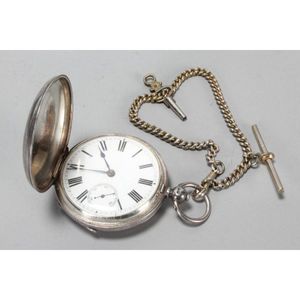Edwardian Sterling Silver Pocket Watch with Provenance
You must be a subscriber, and be logged in to view price and dealer details.
Subscribe Now to view actual auction price for this item
When you subscribe, you have the option of setting the currency in which to display prices to $Au, $US, $NZ or Stg.
- Edwardian - The Edwardian period of English furniture and decorative arts design is named for Edward VII (1841 ? 1910) who was King of the United Kingdom and the British Dominions and Emperor of India for the brief period from 1901 until his death in 1910. It follows the Victorian period, in turn was followed by the Art Nouveau and Art Deco styles. In Australia, designs of this period are also known as being in the Federation style.
- Subsidiary Dial - On a clock or watch, a subsidiary dial, also called an auxiliary dial, is a dial that is secondary to the main dial and may show seconds, day of the week or month, or strike silent. A subsidiary dial may be within our outside the main dial, and a clock or watch may have several subsidiary dials.
- Engine Turned - Engine turning is a decorative technique used on metal surfaces to create intricate curving or geometric pattern. The process involves cutting a series of lines into the surface of the metal using a rose engine or decoration lathe which rotates the metal as it cuts, allowing the operator to create a repeating pattern that covers the entire surface. The resulting surface has a shimmering, reflective quality that is often described as "engine turned." Where an engine turned item has been enamelled, the term used to describe the decoration is usually guilloche.
Engine turning was originally developed to decorate metal objects such as firearms, scientific instruments, and other metal objects that required precise and elegant design. - Movement - The technical name for the workings of a clock or watch, and does not include the dial or case.
- Sterling Silver - Sterling silver is a mixture of 92.5% pure silver and 7.5% of another metal, usually copper. Fine silver is 99.9% pure silver, and is relatively soft and the addition of the very small amount of copper gives the metal enough strength and hardness to be worked into jewellery, decorative and household objects.
This item has been included into following indexes:
Visually similar items

Continental silver cased half hunter watch marked. 935 with key

A fine silver Charles Baume Geneve pocket watch, circa 1920, white dial, black Roman numerals & hands, second subsidiary dial, key wind movement, marked Baume Geneve 127502

A 19th century Swiss silver hunter pocket watch, the case stamped 800 with hallmarks. Swiss lever movement made for the Turkish market. N.139838. Enamel dial with minor repair. Diameter 56 mm.

An English sterling silver pocket watch, Birmingham, white dial, black Roman numerals, one missing hand and glass, filigree engraved case
